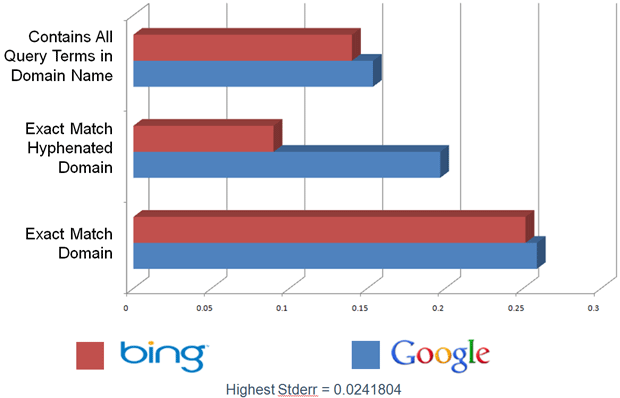Domain
Domain names are the human-readable Internet addresses of websites. Root domains, which are identified by their domain names, have extensions such as .com, .org, .net, etc. (Ex. http://www.example.com) Subdomains are a lower-level component of a root domain and precede the domain name. (Ex. http://subdomain.domain.com)
Top Tips
- Word Separators
Avoid hyphens. Hyphens detract from credibility and can act as a spam indicator. - Top-Level Domain (TLD)
Top-level domains (like .com) are the extensions associated with domain names. For best ranking results, avoid uncommon top-level domains (TLDs). Like hyphens, TLDs such as .info, .cc, .ws, and .name are spam indicators. - Length
Avoid domain names longer than 15 characters. Short domain names are easier to remember, easier to share, and have a smaller chance of resulting in typos.
What are Domains?
Root Domains
A root domain is the top level hierarchy of a domain. Root domains are purchased from registrars. The following are examples of root domains:
- *.example.org
- *.moz.com
- *.blogspot.com
Subdomains
A subdomain is a "third level" domain name that is part of a larger, top-level domain. For example, "blog.example.com" and "english.example.com" are both subdomains of the ".example.com" root domain. Subdomains are free to create under any root domain that a webmaster controls.
The two most common subdomain choices are:
- http://www.example.com (www is the subdomain)
- http://example.com (has no subdomain)
These are also the subdomains that commonly result in canonicalization errors.
SEO Best Practice
To maximize search engine-referred traffic, it is important to keep each of the following elements in mind:
1. Domain Name Memorability
There are a number of considerations when selecting a domain name. Among them are making the name short, easy to remember, and easy to type. It is also important that the name be easy to type into a browser. This is especially true for websites that rely on word-of-mouth advertising, which forces people to type domain names they might not be familiar with into their web browser.
2. Keyword-rich domains
Ideally, webmasters should strike a balance between finding a catchy, unique, brand-friendly domain name and having a domain that contains keywords they are trying to target. The benefit of a keyword-rich domain is two-fold. First, the domain name itself is a ranking factor that the engines consider when calculating ranking order. Second, having relevant keywords in a domain name is beneficial because the domain name is the text that other Internet users will use as anchor text when linking. Since keywords in anchor text are an important ranking factor, having these keywords in a domain name can have a positive impact on ranking.
In recent years Google has made several changes that have de-prioritized sites with keyword-rich domains that aren't otherwise high-quality. Having a keyword in your domain can still be beneficial, but it can also lead to closer scrutiny and a possible negative ranking effect from search engines—so tread carefully. For more on this topic, read The Exact Match Domain Playbook: A Guide and Best Practices for EMDs.
3. Hyphens
If your domain name is two words (like www.examplesite.com), you may want to separate the words with a hyphen for readability: www.example-site.com. That said, use of hyphens also correlates highly with spammy behavior—and more than one hyphen should not be used in a domain name. For this reason, it's generally better to stick to domain names containing only one or two words.
4. Non-.com Top-Level Domains (TLDs)
When a webmaster registers a domain name, they will be given the option to buy additional TLDs. In order to maximize the direct traffic to a domain, it is advised that webmasters should only buy a domain if the .com version is available. Additionally, it is not recommend that SEO-conscious webmasters purchase low quality TLDs such as .biz, .info, .ws, .name, etc. as a means of increasing traffic.
5. Subdomains or Sub-folders
Since search engines keep different metrics for domains than they do subdomains, it is recommended that webmasters place link-worthy content like blogs in subfolders rather than subdomains. (i.e. www.example.com/blog/ rather than blog.example.com) The notable exceptions to this are language-specific websites. (i.e., en.example.com for the English version of the website).
6. Buying & Redirecting Domains
Buying web pages for their links and redirecting them to another site has long been a practice employed by SEOs. Though this has been effective in the past, industry leaders such as Search Engine Land's Danny Sullivan have posted about buying domains. They suggest that Google largely devalues links from sites once they are expired or when ownership changes.






your blog is very nice.....i have read your all blog post...thanks for sharing..
ReplyDeleteSEO Specialist in Bangalore
Digital Marketing Company Bangalore
Mobile seo packages
This is really nice post works well and easy to configure...thanks for all info.
ReplyDeleteTrademark Registration Services In Nashik
Software Development Service In Nashik
Quality Management Services In Nashik
Digital Marketing Services In Nashik
Franchise Consultant In Nashik
you would not really want to deal with those rip-off travel agents”
ReplyDeletewebcare360
I was reading your article and wondered if you had considered creating an ebook on this subject.
ReplyDeleteoffshoreservers.net